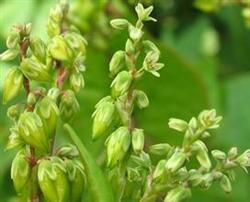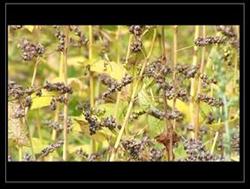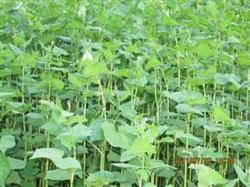Cultivation techniques of bitter buckwheat in autumn

(i) Selection of varieties. Tartary buckwheat varieties with many branches, concentrated seed setting, early seed setting, high seed setting rate, strong cold resistance and high yield were mainly selected. (2) Fine soil preparation. Soil preparation requires fine, tillage depth of about 20 cm, removal of previous crop residues and weeds, conducive to seeding and emergence, deep ploughing and fine harrowing, so that the land is flat, and pay attention to ditching drainage. (iii) sowing at the appropriate time. In the case of competing with other crops, sow as early as possible to avoid frost damage in the later stage. The planting area of buckwheat in our county should be sown before the beginning of autumn. The sowing depth depends on the soil type of the planting area, preferably 3~4cm. The sandy loam is slightly deeper, the clay loam is slightly shallower, and the covering soil thickness is consistent. (4) Reasonable close planting. Sowing density is determined according to soil fertility conditions, and the sowing rate is generally controlled at 5~7kg per mu. When sowing, the row spacing is 30~35cm and the hole spacing is about 20cm; when sowing in drill, the sowing width is 10~12cm and the row spacing is 30cm. (5) Scientific fertilization. Fertilizer application should follow the principle of "applying sufficient base fertilizer, applying top fertilizer early, applying phosphorus and potassium fertilizer appropriately". 750~1000 kg farm manure per mu, 15~30 kg calcium superphosphate as base fertilizer. 3~4 seedlings appear weak at true leaf stage, 2.5~ 5kg urea per mu is used to raise seedlings, and at initial flowering stage, 0.15~ 0.2kg potassium dihydrogen phosphate and 0.5~ 1kg urea can be sprayed on 60~ 75kg water for 2~3 times per mu to ensure sufficient nutrient supply at later stage, reduce bud drop and improve seed setting rate. (vi) Field management. (1)Thinning seedlings. When seedlings 3~4 true leaf stage, the seedlings of the plot and section too dense to thin, to weak and strong, to dense and thin. Ensure that there are about 200 seedlings per square meter. (2)Promote branching, control flourishing. Under the condition of higher water and fertilizer, the growth is vigorous. Spraying 100~200ppm paclobutrazol solution 40~50 kg/mu at the initial stage of bud emergence has the effects of reducing plant height, increasing branches, resisting falling and increasing yield, increasing yield by more than 15%. (3)insect control. Insect pests are mainly used in flowering stage, supplemented by insect pests in seedling stage. 2~3 times with kungfu, enemy kill and other pesticides. (7) Timely harvest. When 2/3 of the seeds of the whole plant are brown or silver-gray, it is suitable for harvest. In order to reduce seed loss, harvest should be carried out from early morning dew drying to 11:00 a.m., and gently cut and release. After cutting, sun drying and ripening for several days, threshing nearby to reduce loss.
- Prev

High-yielding cultivation techniques of autumn buckwheat
Buckwheat is rich in a variety of minerals and vitamins and has unique nutritional value. it has become a new generation of coarse grain green nutrition and health food, and it is a kind of food crop with high nutritional value and medical value. Focus on the following six techniques: 1. Select high-yielding varieties. The improved varieties of buckwheat, West Buckwheat No. 1 and West Buckwheat No. 2, were mainly promoted. 2 、...
- Next

Key points of cultivation techniques of buckwheat
Buckwheat is a good crop for filling leisure and disaster relief because of its short growth period, strong adaptability, moderate yield and high value of nutrition and health care. There is a habit of growing buckwheat all over our county. In order to achieve a stable yield and bumper harvest of buckwheat after the disaster, we must grasp the following key technical links: 1. Select improved varieties. It is appropriate to choose a growth period of 70 Mel for 80 days, with stress resistance.
Related
- The first cup of black tea in spring, the flavor and history of tea gardens in Kenya, Africa
- The computer can not only choose potatoes, but also grow tea rice. AI will grow winter oolong tea champion.
- It is not only the inflated tea bitten by insects, but also engraved with the four seasons tea in Beipu.
- The Oriental Beauty Tea Festival in Zhuxian County takes the stage at the weekend to experience the plus-size feast of oil tea.
- & quot; Oriental Beauty Tea & Exploration of Emei in Hsinchu, the hometown of quot;
- The new variety of strawberry "Tainong 1" dessert is the first choice with mellow aroma. Crimson gorgeous
- History of Tea in Taiwan: from Wild Inner Mountain to Export Tea Garden
- Two types of Taiwan Oriental Beauty Black Tea won the British three-Star Award for Childhood Tea Xiang Zhang Jiaqi changed from pilot to champion tea maker.
- Banana species and varieties: the planting history of Taiwan Xianren banana and dwarf banana is long, is banana disease resistant?
- Coffee planting Technology: Qianjie Coffee from Seedling to harvesting

